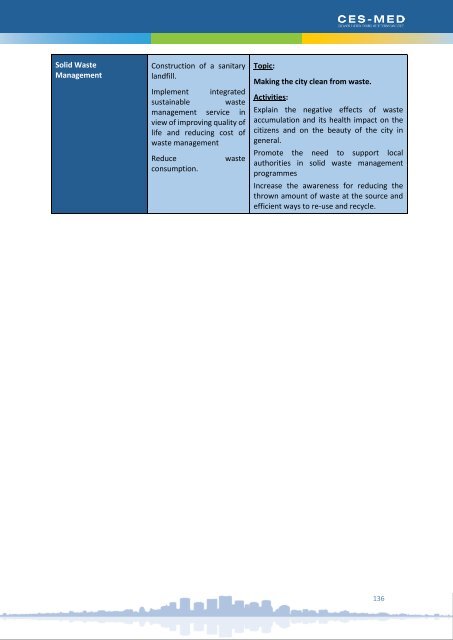1711_SECAP Karak - SET
You also want an ePaper? Increase the reach of your titles
YUMPU automatically turns print PDFs into web optimized ePapers that Google loves.
5.5 #5 - Making the Municipal Buildings Green<br />
Making the Municipal Buildings Green - # No 5<br />
1. General Presentation<br />
Location<br />
Start date<br />
Project Lifetime<br />
Al-<strong>Karak</strong> governorate TBD TBD<br />
Eng. Fatima Kafaween<br />
Eng.fatima@yahoo.com<br />
Project Owner / Lead Actor<br />
Al-<strong>Karak</strong> Greater Municipality<br />
Contact person<br />
0799032211Summary of the Action<br />
<strong>Karak</strong> Municipality wants to make its municipal buildings efficient and green. This can be through actions in the building envelope,<br />
namely walls, roofs and windows. Some of the best options in order to make the buildings more efficient are the insulation of walls<br />
and roofs and the use of double glaze windows.<br />
According to the municipality staff, all municipal buildings have already installed efficient lighting units (LED technology) and new<br />
AC units, where the latter constitute about 50% of the annual energy consumption in the municipal buildings. Also it was considered<br />
that the municipal buildings’ envelope does not have thermal insulation, while their windows are of single glaze type and present<br />
air infiltration. This means that improving the building envelope (thermally insulating the walls and roofs and replacing the single<br />
glaze windows with double glaze ones) will reduce the heat losses in the buildings and thus reduce the energy consumed in the AC<br />
units for heating and cooling. Moreover the municipality wants to take benefit of the solar potential of the region to increase the<br />
local production of renewable electricity. By doing so it will reduce its dependency on the grid, through the installation of PVs<br />
wherever possible on the municipal buildings’ roofs. The total available roof area is around 5,000 m 2 , almost half of the total roof<br />
area, according to Municipality Staff (detailed calculations are provided below).<br />
More specifically:<br />
<br />
<br />
Regarding the PV system, as it is mentioned above, the total available roof area is 5,000 m 2 , thus the maximum installed capacity<br />
of panels is 500KW. It is also calculated that, assuming a 19.4% capacity factor for <strong>Karak</strong> region, namely a total of 1,700<br />
production hours annually, the estimated annual electricity production is 850MWh. Moreover the annual monetary savings,<br />
based on the fact that 1 KWh costs 0.12 JOD and 1 JOD=1.31€. will be 102,025 JOD (133,652€).<br />
As for the building’s envelope, in the next figure are presented the respective savings, considering also the energy consumption<br />
forecast in 2030 (Baseline as Usual Scenario – BAU), calculated based on the increase coefficient for Jordan of 1.68 (baseline<br />
year 2014).<br />
Energy consumption in the<br />
municipal buildings (MWh)<br />
123<br />
Share percentage of air<br />
conditioning system in the<br />
overall building<br />
consumption<br />
Energy Saving in the air<br />
conditioning system due to<br />
the building envelope<br />
measures<br />
Energy savings<br />
(MWh/year)<br />
5,104.6 50% 35% 1,500<br />
Thus based on the previous rates, it derives that municipality can save 152,891 JOD (200,287€).<br />
As far as the investments are concerned, the costs for the above projects have been calculated as follows, depending on estimations:

















